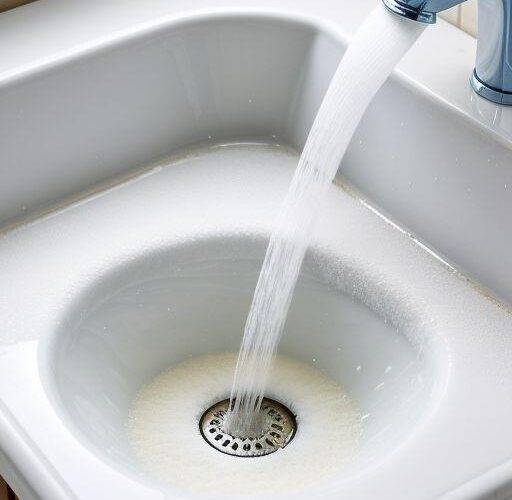To get rid of mold in pipes, flush the system with a disinfectant like bleach or vinegar, and clean fixtures thoroughly.
If the problem persists, call Tip Top Plumbing & Restoration in Pembroke Pines, FL, at 954-289-3110 for professional mold remediation services.
Mold can develop inside plumbing when moisture, organic matter, and low water flow allow spores to settle and spread. The growth can cause musty odors, odd-tasting water, skin irritation, or allergy-like symptoms. You may also notice mold around faucets or inside aerators.
In this guide, you will learn how to safely and effectively remove mold from your water pipes using tools you likely already have at home.
Step-by-Step Instructions to Get Rid of Mold Growth
Shut Off the Water Supply to Your Home
Turn off the main valve to stop the water flow. This helps prevent mold spores from spreading further during the cleaning process.
Drain All Faucets and Fixtures
Open all faucets, including those in the kitchen, bathroom sink, and shower. Fully drain the water pipes and supply pipes to prepare for disinfection.
Mix a Disinfectant Solution with Bleach or Vinegar
Use 1 cup of household bleach or white vinegar mixed with 1 gallon of clean water. This solution helps kill all types of mold, including black mold, and neutralizes spores inside your plumbing system.
Pour the Solution into the Affected Water Pipes
Carefully pour the bleach solution into the main drain or pour it directly into isolated pipes if accessible. This allows the solution to target mold growth inside the pipes.
Let the Disinfectant Sit for at Least 1 Hour
Allow time for the solution to break down the mold buildup. Letting it sit ensures deeper mold removal from the plumbing lines

Flush the Entire Plumbing System with Clean Water
Turn the water supply back on and run all faucets to rinse out the bleach or vinegar. Let it run for at least 10–15 minutes to flush any remaining mold spores.
Clean Faucet Aerators, Showerheads, and Sink Drains
Remove aerators, showerheads, and drain stoppers. Soak them in vinegar or a baking soda and water mix. Scrub thoroughly to remove trapped mold.
Sanitize Bathroom Fixtures and Kitchen Sinks
Scrub around bathroom sinks, shower drains, and faucets using the same disinfectant. Mold often hides in damp bathroom areas and behind fittings.
Inspect for Mold in Hidden Pipe Areas
Check under cabinets, behind the bathroom sink, and around drain connections for signs of mold or water damage. Use a flashlight for hard-to-see areas.
Repeat Cleaning If the Mold Smell or Taste Returns
If you still notice a musty smell in your drinking water or around drains, repeat the cleaning process. Mold exposure through contaminated water can cause infections or allergic reactions.
Call a Professional for Persistent Mold or Water Damage
If mold continues to return, call Tip Top Plumbing & Restoration at 954-289-3110. Professional mold removal services can handle deeper mold growth and inspect for hidden issues in your pipes.
Tips for Preventing Mold Spores in Your Water Pipes
- Run faucets weekly in unused areas like guest bathrooms to keep water flowing.
- Pour boiling water down drains to break down organic buildup and reduce mold growth inside your plumbing system.
- Use baking soda and vinegar or a mild disinfectant to clean sink and shower drains.
- Check for leaks or standing water in bathrooms. Fix any leaks promptly.
- Install drain filters in sinks and showers to catch hair, soap, and debris.
- Schedule regular maintenance of plumbing lines to catch hidden mold growth early.
Protect Your Pipes and Stop Mold Before It Spreads
Unchecked mold in your drains and pipes can lead to costly damage and health issues. Stay proactive – monitor for signs, clean regularly, and act fast when problems appear.
If mold keeps coming back, reach out to Tip Top Plumbing & Restoration for mold removal and a full-system inspection. We serve Pembroke Pines and its surrounding areas with professional mold removal, backed by affordable pricing, transparent estimates, and high-tech solutions. Our services adhere to IICRC guidelines to ensure your pipes remain clean, safe, and compliant.
Call 954-289-3110 to schedule service.
FAQs
Can mold in pipes lead to health risks and infections?
Mold exposure from contaminated drains or faucets can cause skin irritation, allergies, coughing, or worsen asthma, especially in sensitive individuals. In some cases, prolonged exposure may lead to infections, particularly in people with weakened immune systems or pre-existing respiratory conditions.
Can you live with black mold in your house?
Living with black mold in your home is unsafe. Prolonged exposure can lead to serious health issues such as respiratory problems, allergic reactions, chronic coughing, or infections, especially for children, the elderly, or those with weakened immune systems.
What should I do if I see mold in my house?
If you notice mold in your home, take action promptly. For small spots, use a safe cleaning solution, such as vinegar or diluted bleach, to remove them. Avoid disturbing the area without protection. If the mold continues to return or covers a large area, contact a certified mold removal professional to inspect and treat the source safely.
Can mold exposure affect pets in the home?
Mold exposure can affect pets just as it does humans, causing symptoms such as sneezing, coughing, skin irritation, or lethargy. Prolonged exposure may lead to more serious health issues in sensitive animals.
Can mold go away permanently?
Mold can be permanently removed if the source of moisture is addressed and all affected areas, including drains and pipes, are thoroughly cleaned and properly maintained. However, if conditions such as dampness, organic buildup, or poor ventilation persist, mold may grow back.
